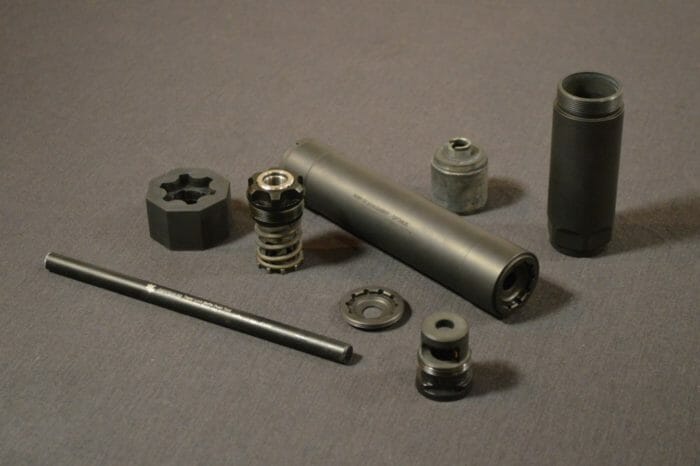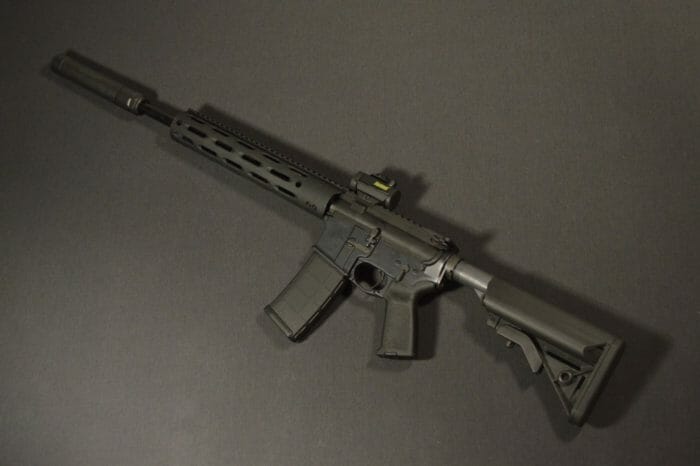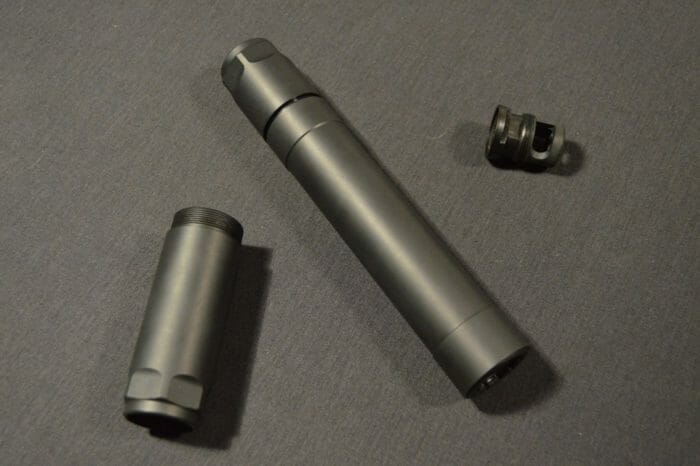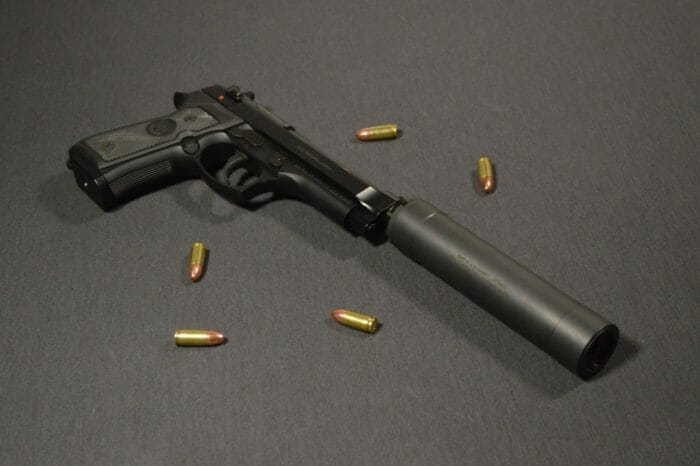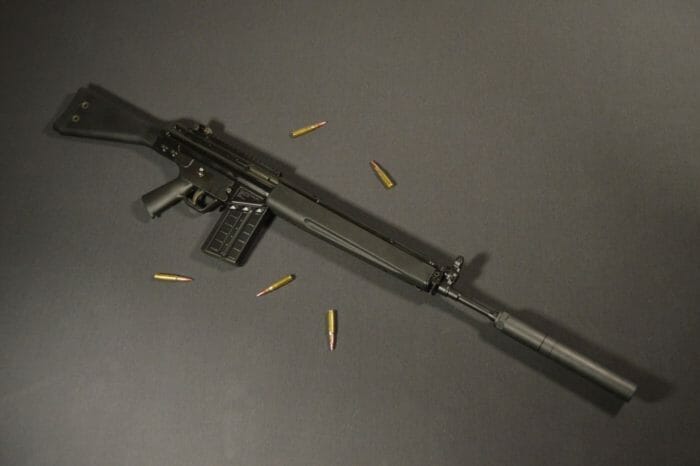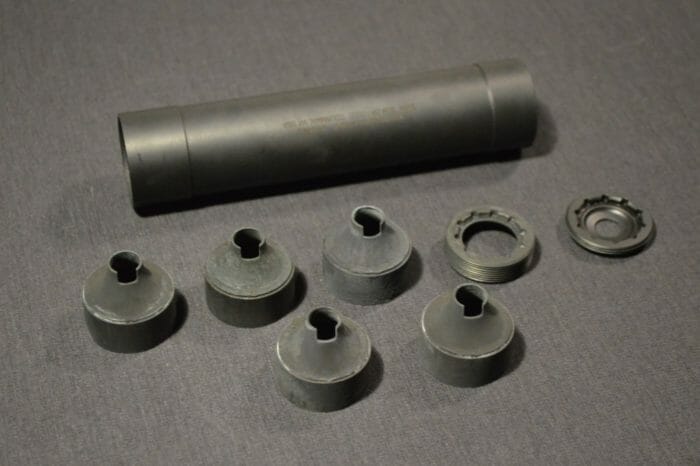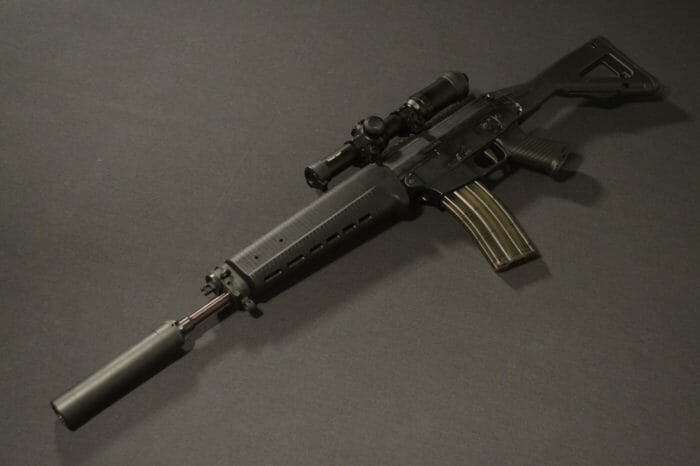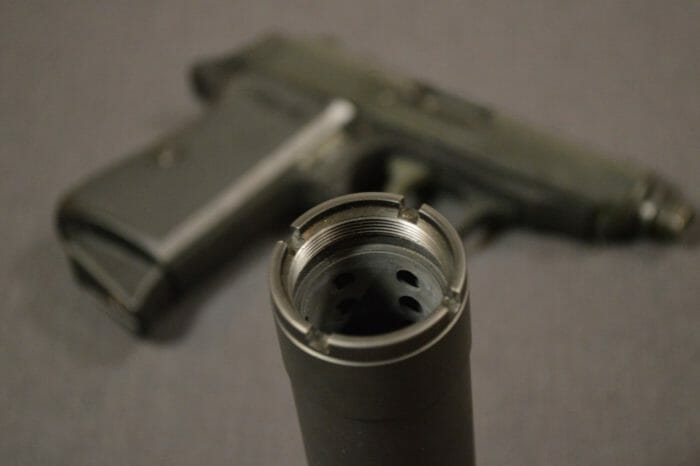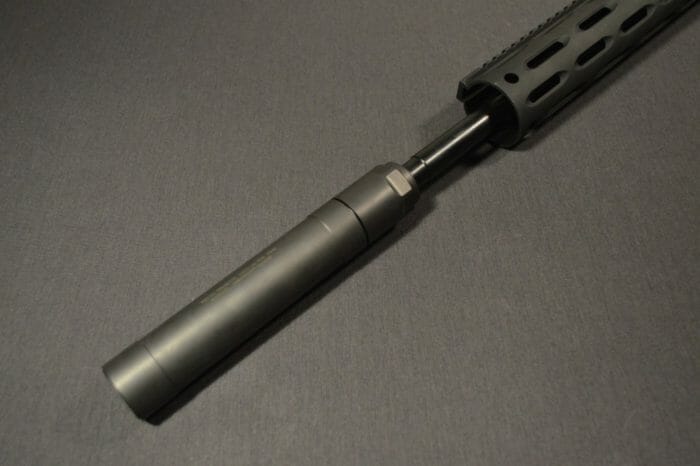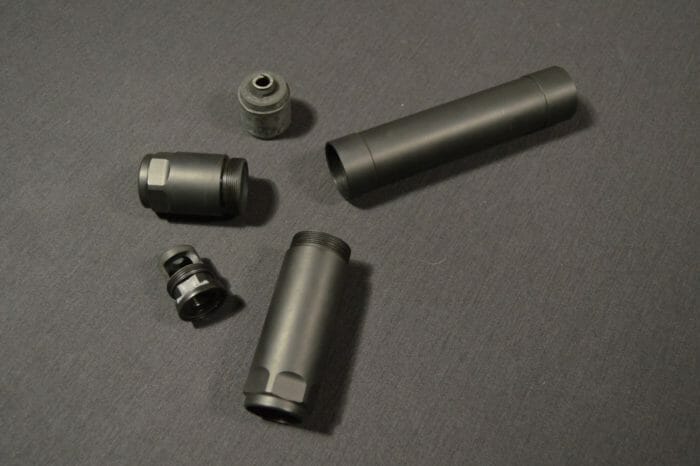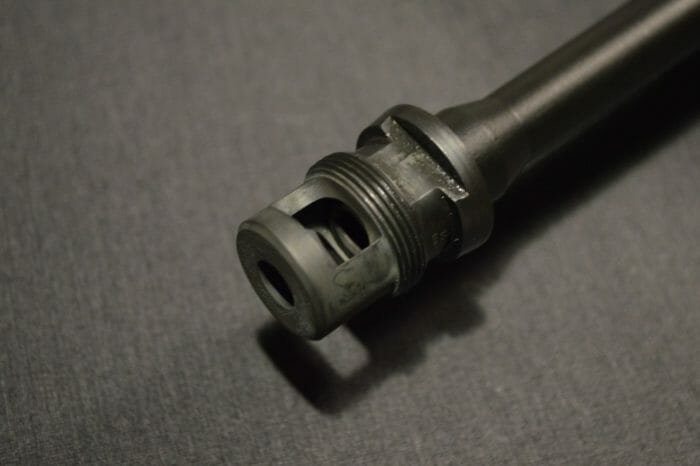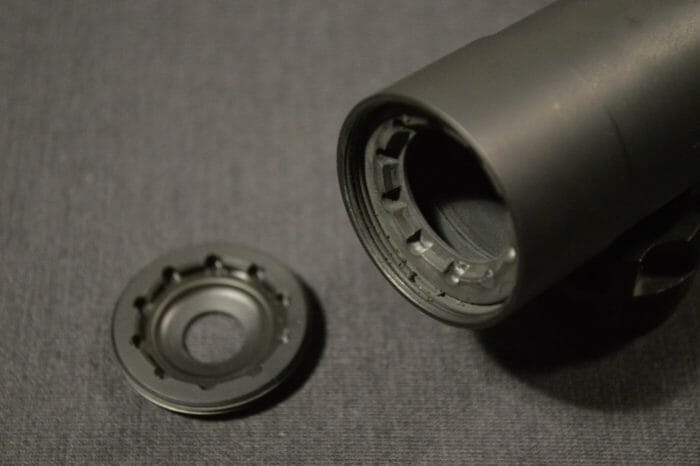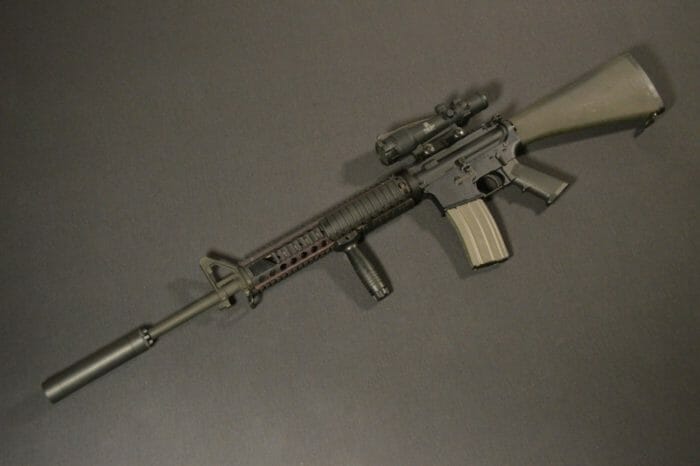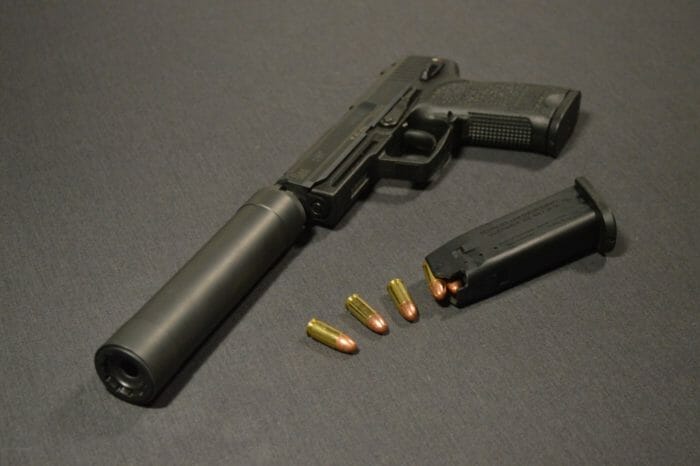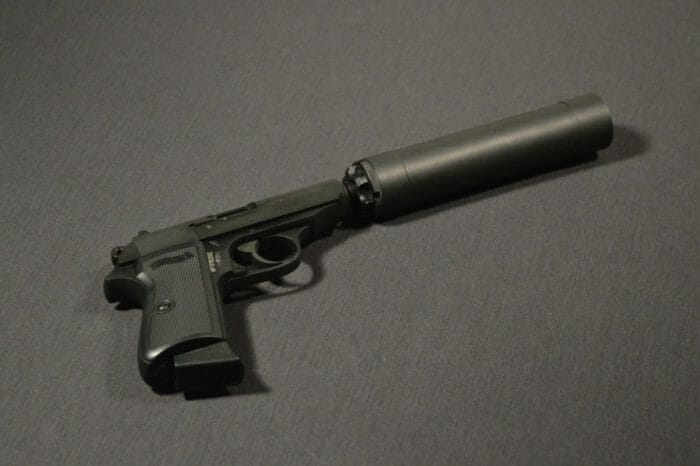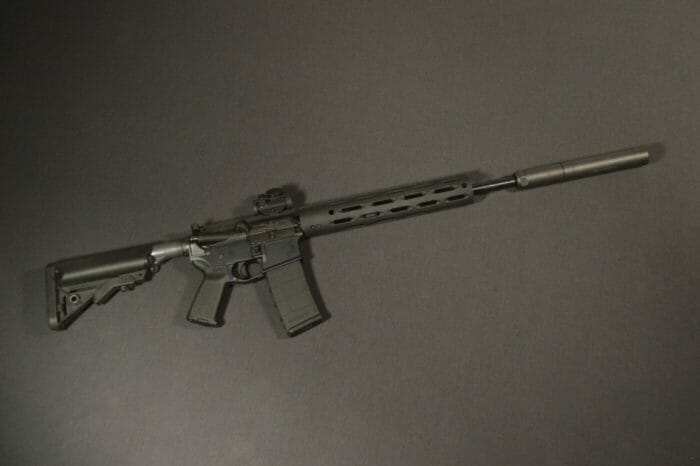Silencer Shop Authority: Griffin Armament Optimus Review
For as long as I’ve been involved with suppressors, cardinal rules of NFA ownership have stated that shooters need at least three separate silencers to cover every main type of firearm. Excluding shotguns, most guns can be tamed using one of the following: a .30 caliber rifle silencer, a .45 ACP pistol can, or a .22 caliber rimfire suppressor. While owning three distinct silencers will suit most people very well, building such a collection can be very pricey. Suppressors themselves simply are not cheap, and adding $600 ($200 each) in tax stamps on top of the cost frequently turns away all but the most dedicated.
Thanks to a few creative companies, the suppressor paradigm is set to change in 2016. At the end of last year, both Griffin Armament and SilencerCo announced that they had developed highly adaptable, multi-caliber silencers that could effectively suppress most popular calibers. Griffin’s offering, the Griffin Armament Optimus 9, was the first to market and is rated for use with virtually anything that fits through its 9mm aperture, up to .300 Winchester Magnum. Thanks to the folks at Silencer Shop, I was able to spend the last two weeks examining this revolutionary suppressor.
Size and Weight
With so many configuration options, keeping tabs on the Griffin Optimus’ size can seem quite challenging. There are just three different length options to consider. In its long and mid-length configurations, the Optimus is best suited for rifles and measures in at 9.4” and 7.9” respectively. The Optimus’ short format results in a 6.6” silencer that is comfortably at home on pistols, pistol caliber carbines, and .300 BLK rifles.
Something unique about the Griffin Armament Optimus as compared to typical rifle suppressors is that Griffin’s newest silencer is only 1 3/8” in diameter. The industry standard for rifle cans is 1 1/2”, so the Optimus is very slim and should fit under more handguards than competing options. It also is far more practical on a pistol than a 1 1/2″ silencer would be. A downside to the design is that the slimmer tube sacrifices considerable internal volume, which can hinder performance. I’ll speak to the Optimus’ sound quality later on.
Thanks to its skinny profile, the silencer is uncharacteristically light for its length. By itself, the Griffin Optimus weighs 18.1 ounces in its full-size configuration according to my digital scale. With the included 1.7 ounce Minimalist Taper Brake, the Optimus’ total system weight is just 19.8 ounces, over three ounces lighter than my Specwar 556 with an ASR muzzle device. In its mid-length configuration, the Optimus weighs 16.2 ounces while the shortest arrangement comes in between 12.3 and 14.3 ounces. The exact weight of the Optimus’ short configuration will depend on whether the can is set up to mount via 3-lug, direct thread, or piston. As you might expect, the suppressor is a few ounces heavier with the 3-lug and booster assemblies as opposed to the simple threaded rear cap.
Materials and Design
The Griffin Armament Optimus is constructed entirely of 17-4 stainless steel with a Melonite QPQ finish for added durability, increased corrosion resistance, and easier cleaning. At most operating temperatures (sub-1,000 degrees Fahrenheit), 17-4 rivals the strength of more expensive alloys, such as Stellite, and Griffin has approved the Optimus’ long configuration for use with .300 Win Mag rifles (24” barrel minimum). 17-4 has been used in muzzle devices for a very long time, and I have no problem with Griffin using it in their suppressors. It also happens to be lighter than Stellite or Inconel alloys.
Since there are a few different ways to configure the Optimus, I think it is best to start with the suppressor’s main tube and smallest setup. This allows us to cover the pieces that stay mostly consistent as users reconfigure the can for different applications.
Removing the Optimus’ baffle stack can be done very simply by unscrewing the removable end cap and inner retaining ring at the front of the can. Griffin includes both .22 caliber and 9mm end caps with the Optimus, so be careful not to get the two mixed up. Like SilencerCo’s Octane series cans, the piston can be used as a tool to remove the end cap and retaining ring if they’ve been fastened too tightly. Once these two parts are out, the baffles should slide right out the front.
Inside the main tube are five clipped cone baffles with 9mm apertures that look very similar to the ones in Griffin’s Revolution series silencers. Each baffle is made of QPQ-treated 17-4 stainless. Also, like the Revolution and Octane cans, the Optimus’ stack clicks together. This feature aids in reassembly and seals the outer tube against debris and lead.
In order to use the Griffin Armament Optimus in its short configuration, the booster housing, or encapsulator, must first be installed. Thankfully, Griffin has slotted this part for a standard AR-15 castle nut wrench. To prevent loosening at the range, I highly recommend using such a wrench to tighten the housing. With it installed, direct thread rear caps, the Nielsen device, and the 3-lug assembly (sold separately) can be attached to the can. Most pistols will obviously require the booster, while fixed barrel carbines are likely to use the direct thread and 3-lug attachments. Fortunately, the Optimus uses Griffin’s widely-available Revolution pistons, and in a pinch (not recommended), the silencer is also compatible with SilencerCo’s Octane/Osprey pistons. Likewise, those with Revolution suppressors will be happy to know that Griffin has carried the same direct thread adapters over from that series. To help with servicing, Griffin includes a disassembly tool that makes it easy to remove stuck thread adapters and pistons.
Moving up to the mid-length configuration involves replacing the booster housing with the included spacer baffle and adding Griffin’s Minimalist Blast Shield (sold separately). In this format, the can is only compatible with Griffin’s Minimalist muzzle devices, so shooters looking to use standard Taper Mounts may be disappointed. In my opinion, the mid-length configuration offers the best balance between size and performance. It is also the shortest configuration to be rated for .308 usage (16” barrel minimum).
Going from the mid-length setup to the full-size configuration is as simple as removing the Minimalist Blast Shield and attaching the included standard Taper Mount Blast Shield. Unlike the last configuration we discussed, this format facilitates the use of the Optimus with Griffin’s full line of Taper Mount muzzle devices. The full-length arrangement is the only one that Griffin rates for use with .300 Win Mag.
Featured with many of Griffin’s suppressors, the Taper Mounts are among the best in the industry. The system does not actively lock the can to the mount, but the close fit of the taper and the silencer is more than enough to keep the suppressor from backing off during use. With no wear surfaces, the Taper Mounts should essentially last forever, and unlike some quick attach systems, they allow for true one-hand attachment and removal. Furthermore, since the silencer mounts flush with the back of the muzzle device, Griffin suppressors add slightly less length to a rifle than rival designs. Shooters who still aren’t sold on the Taper Mounts will be happy to know that Griffin has just released an A2 Blast Shield (sold separately) that allows the Optimus to be used with NATO muzzle devices.
Range Report
As you might expect, I chose to start my range time with the Optimus at the upper end of the power spectrum. With the can mounted on my PTR-91 A3R from Atlantic Firearms, I was not surprised to find that the rifle became rather unwieldy. A relatively long silencer at the end of an already large .308 battle rifle is bound to be a front-heavy boomstick, but it is also important to remember that the Optimus is significantly lighter than many caliber-specific silencers.
The Optimus’ performance with the stout .308 cartridge was remarkable. At first, I anticipated that the large bore aperture and small diameter of Griffin’s suppressor would substantially handicap its ability to tame most rifle rounds. I was absolutely wrong.
To my surprise, the Optimus sounds very similar to leading .30 caliber suppressors. According to recent testing by Silencer Shop (video coming soon), the Optimus can be expected to perform in the 136 to 137 dB ballpark on .308 hosts. Silencer Shop’s numbers are based on the full-length configuration, but I found the mid-length setup to be roughly as quiet. For some context, this sort of showing puts the Optimus on par with highly regarded options, like the AAC 762-SDN6 and SilencerCo’s Saker.
Watching the videos below, you will notice that I encountered some problems with the Griffin Optimus mounted to my PTR-91. The rifle’s roller locking system relies on properly tuned backpressure, and adding a silencer to any HK-style rifle can lead to reliability challenges. With the Optimus attached, my rifle’s bolt speed increased to a point where it not only became unpleasant to shoot, but it also failed to feed on a couple of occasions. As much as I would like to blame the cheap ammunition for these failures, it is more likely that the runaway bolt and carrier were the main culprits. To prevent this in the future, I will be installing a new locking piece that should help to slow the system.
The Optimus’ performance on my .300 BLK upper from Radical Firearms was even more impressive. While I am admittedly new to the BLK bandwagon, I’ve heard enough pistol and rifle suppressors to know that the Optimus holds its own and is definitely hearing safe with subsonic ammunition. During testing, I was also shooting Remington’s notoriously loud 220 grain pills. In its 9.4” length, the Optimus once again performs approximately as well as high-performance silencers, with minimal first round pop (FRP) and average sound pressure levels (SPL) in the 127 dB range.
I spent the least amount of time with the Optimus on my M16A4 clone. Part of this was due to a mount shortage, but I was also incredibly excited to try the can on my .30 caliber hosts. That said, I tested the silencer in its shortest configuration, and it performed admirably. I would estimate that at the muzzle, this short format probably meters in the upper 130 to lower 140-decibel range on your average AR-15. Since most 5.56mm suppressors tend to be very gassy, I was pleased with the can’s lack of blowback, and my impression was that the short Optimus probably offers at ear performance in line with leading 5.56mm silencers. For those curious about the full-size configuration on 5.56mm hosts, Silencer Shop has metered the silencer at around 133 dB. That’s a remarkable showing for a suppressor with a 9mm aperture.
Unfortunately, while switching back and forth between .300 BLK and 5.56mm, I forgot to replace the .22 caliber end cap with the 9mm version. The results were predictable. After three rounds of .300 BLK passed through the undersized cap, the part gave way and launched downrange never to be seen again. As you might imagine, seeing a part of the can fly in the general direction of my target was both alarming and incredibly embarrassing. I coached myself before leaving for the range that I needed to pay attention to the cap, yet I still forgot. Remarkably, the tube itself sustained absolutely no damage in the incident. If I learned nothing else, I think the mishap officially sold me on the Optimus’ durability.
Moving down to 9mm handguns brings us to what I feel is the Optimus’ only real weakness. Compared to my Octane 45, the Optimus was most certainly the louder silencer and its pitch was higher as well. Since the Optimus is nearly 2” shorter than the Octane, these results should not be surprising. At the range, I estimated Griffin’s can to meter at around 130 to 131 dB and Silencer Shop’s 133 dB results support my assumption. Since these numbers are 5 to 10 dB louder than top performing 9mm cans, the Optimus’ disadvantage is quite noticeable. Perhaps a more apt comparable for the Optimus would be Griffin’s Revolution 9 in its short configuration, which is more similar in size and performance.
Lastly, I tried the Optimus on my SIG 522 and Walther PPK/S .22. With subsonic rimfire ammo, the silencer sounds ridiculously good at the muzzle, the Optimus meters louder than true .22 caliber suppressors. However, to the shooter, it sounds better than many top rimfire cans, thanks to its massive internal volume and negligible backpressure. It also looks far better on the SIG than most rimfire silencers. While the Optimus is far too large and too heavy for most .22 caliber guns, it does suppress them with commendable efficiency.
Conclusion
Griffin Armament’s Optimus may be the first of its kind, but it has certainly set a high bar for those that will inevitably follow. Thanks to its surprising performance and plethora of configuration options, the Optimus 9 has fairly earned its place as my favorite product of 2015, a claim that I do not make lightly. Honestly, the adaptability of the silencer is remarkable, and I think Griffin was wise to make it a 9mm suppressor, rather than accommodating much larger .45 ACP. At well under $1,000 from Silencer Shop, budget-conscious shooters who have yet to make the NFA jump would be especially wise to consider the Optimus as a first silencer.
An information security professional by day and gun blogger by night, Nathan started his firearms journey at 16 years old as a collector of C&R rifles. These days, you’re likely to find him shooting something a bit more modern – and usually equipped with a suppressor – but his passion for firearms with military heritage has never waned. Over the last five years, Nathan has written about a variety of firearms topics, including Second Amendment politics and gun and gear reviews. When he isn’t shooting or writing, Nathan nerds out over computers, 3D printing, and Star Wars.

